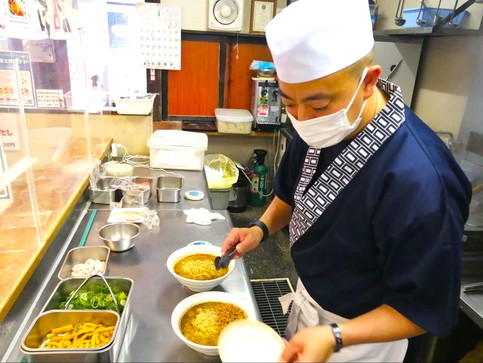Updated: June 2022

JCI's professional Ramen Course has resumed for the first time in almost two years following the Yakitori Lessons after being suspended due to the COVID19 disaster.
Ramen is a simple dish consisting of noodles, soup, and toppings. Within this dish, hundreds, thousands, tens of thousands, or even more unique ramen dishes are studied and consumed throughout Japan every day.
JCI's lessons will teach you the skills of a ramen master, so you can make them. Plus, you'll train your palate by going on food trips to some of Japan's very best ramen restaurants!
Not only that, but each student will be thoroughly trained to make ramen to their taste, using their recipe tailored to each student's market and taste. This is the characteristic of JCI's professional lessons. The lesson menu this time is as follows.
Day-1: Making Chashu pork and ramen soup broth
Day-2: Preparing soup with dried sardine/preparing soy sauce and salt-based soup and visit a famous ramen restaurant
Day-3: Making Tantanmen and making a ramen bowl at the ceramic studio
Day-4: Making noodles and Gyoza
Day-5: Preparing Tonkotsu (pork bone) soup
Day 1:Making Chashu Pork and Basic Broth

The master and student cooked Chashu pork and basic ramen broth together. Chashu is made by slowly cooking chunks of pork belly over low heat in a sauce made of soy sauce, sugar, ginger and green onion, etc. It is sliced and used as a topping for ramen. The base broth, made from pork thigh bones and chicken leg tips, is rich, full-bodied, and full of umami. The student's faces lit up with surprise "Oishii!" when they tasted it.
Day 2: Preparing soup with dried sardine/preparing soy sauce and salt-based soup andvisit a famous ramen restaurant
On the second day, the student cooked two kinds(clear and cloudy) with roasted Niboshi(dried baby sardine and horse mackerel) and tasted a combination of salt flavor x hand-tossed noodles and soy sauce flavor x medium thin noodles in clear soup stock, and a variety of salt tare x hand-tossed noodles and soy sauce flavor x thick noodles in cloudy soup stock.
The hand-tossed noodles increase their texture and give them a handmade texture. By comparing the clear and cloudy soups with salt and soy sauce flavor, the student was excited to learn that the same ingredients can look and taste different depending on how they are prepared.
After the lesson, the group went sightseeing at Kadonowaki Suspension Bridge on the Jogasaki Coast in Ito City and visited a ramen restaurant of an owner trained under the famous ramen master Minoru Sano.
Day 3: Making Tantanmen and making a ramen bowl at the ceramic studio
We are now on the third day of the ramen lesson. While the students still have more to learn, the ramen masters are busy working in the kitchens with more to teach!
Today, at the student's request, he tried his hand at making Tantanmen(Dandan noodles). The spicy minced pork topping was seasoned with chili oil, sesame oil, sake, soy sauce, sansho (Japanese pepper), and ground sesame seeds. The students were surprised to hear that the only adjustment for the four levels of spiciness was the amount of chili powder!
The soup is made by seasoning the broth in which the minced pork topping was cooked. The soup stock and the flavors of the toppings combine to create harmony and richness. Eggs are boiled for 7 minutes to make them half-boiled. They were soaked in flavored soy sauce for 15, 20, and 25 minutes, respectively, to compare the color and taste of the eggs. Japanese love this soy sauce egg half-boiled with the creamy yolk! Each ramen shop has its original recipe for this egg.
After the lesson, the student went to the pottery studio to make a ramen bowl and a Yakitori plate and enjoyed two hours of pottery making. See the pictures for the results!
Day 4: Noodle Processing and Temomi-men prep and Gyoza!
Only two more days left of the ramen course!
So far, the student has learned how to prepare soup and toppings, but today is the long-awaited hands-on experience of noodle making. The big challenge was to operate the noodle-making machine and master making firm hand-tossed/rubbed "Temomi" noodles. Now, let me show you how well the student did!
Making noodles using a professional noodle-making machine was, of course, a first experience for the students. Carefully selected flour for making noodles is added to powdered egg, Kansui (brine), salt, and water, then put into the machine. Two types of noodles were made: thick noodles for Tsuke-men with dipping sauce and slightly thinner noodles for regular soup ramen.
The ingredients are mixed, kneaded, rolled in the machine, and cut to the specified thickness. The "Temomi, hand-tossing/rubbing" is then used to create a handmade style texture. This method was taught directly by the noodle-making master on site.
He also cooked Gyoza from scratch. Since he was a child, he had wrapped dumplings, but this was the first time for him to chop vegetables and mix them with ground pork to make a filling. Mixing the ground pork until it is sticky is the key to making Gyoza juicy! After the lesson, the student got photographed with the noodle master.
Day 5: Tonkotsu Broth Preparation
We have finally reached the last day of our final Ramen Lesson!
First, we started by preparing the creamy and rich pork bone broth. We prepared 10 kg of pork backbone in 20 liters of water. Due to time constraints, the soup is usually cooked for at least 8 hours, but they shortened it to 3 hours today.
The pork bones are removed from the pot, and the bones are crushed in the pot with a large bamboo spatula and finally stirred with a mixer drill to create a milky-brown Tonkotsu broth. It is time-consuming, arduous labor, but he enjoyed it!
The pork bone broth, made only from pork backbone, was tasted with special thin noodles. The ramen was so delicious that the students even drank all of the broth. He understood which noodles would be tasty with a specific soup now, and it is essential for mastering ramen.
The side dish was the "Cabbage & Chashu-don," a bowl of rice topped with tender, juicy pork tripe stewed and seasoned with soy sauce and cabbage. Simple, but again, very oishii and even more impressive. During the course, he enjoyed several side dishes and got great ideas about offering different dishes to ramen, which differentiated him from others who only cook ramen.
This ramen lesson was a private lesson, as the participants were limited to residents of Japan due to COVID19. The student's wife also loves ramen, and he wanted to make his delicious ramen at home, so he took this course.
In the lesson, the student learned how to make a variety of ramen soups from scratch and was delighted to work with the instructors so closely. The discovery that clear and tasty broth can be made from only dried sardines without using meat or bones cleared away his image of "ramen = high in cholesterol." He already learned the healthy alternative in the lesson.
After the lesson, he took a picture with the ramen master. It seems like they've known each other for a long time already. We all hope the student continues to blush up his skills after returning home!

Ramen is so famous worldwide. There are many other professional secrets to Ramen broth and noodle preparation! Master ramen master's secrets and recipes with JCI!
For more information about JCI's RamenCourse, click the link.
























































